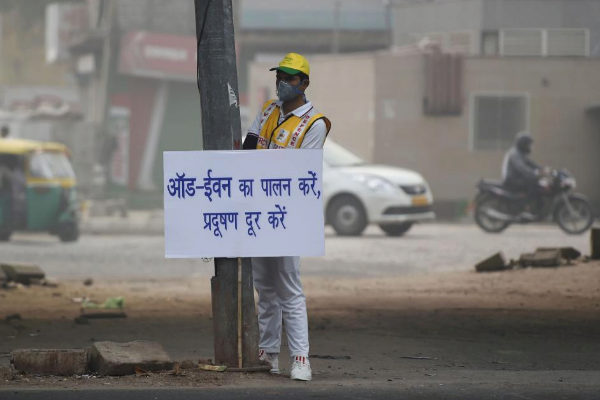- Emergency: Delhi restricts circulation with odd and even days
- Delhi Irrespirable city
- Air: India will spray water over New Delhi to combat the dangerous cloud of pollution that surrounds it
- Yamuna.The urban river of Delhi, the most polluted in the world
A week ago, during the Diwali Festival in New Delhi, smoke columns from firecrackers and fireworks drew a hazy landscape in the city. This Hindu festival, one of the most important in India, symbolizes the triumph of good over evil, the return of the exile of God Rama and his victory over the demon king Ravana. The party ended at dawn. New Delhi lay down bathed in smoke. And he got up with a toxic fog that lasted all week.
On Friday, the Government of India declared a public health emergency in the capital. Politicians talked about a city turned into a "gas chamber." The northeastern wind came with force dragging the smoke of burning stubble from agricultural areas such as Punjab and Haryana. It is the time when farmers clean their fields. What they did not expect was that the particles of their fires (carbon dioxide, nitrogen and sulfur) would reach a city where breathing costs more and more.
Let the children of the schools in the Gurgaon district ask the morning they saw their prime minister, Arvind Kejriwal, give them face masks and brochures in person to learn how to use them. He did the same with the elders. In total, the authorities distributed more than five million masks. Was necessary. Pollution levels were 20 times more toxic than those recommended by the World Health Organization (WHO). The levels of fine particles in the air - known as PM 2.5 - reached 533 micrograms per cubic meter when it is advisable not to exceed 25 micrograms.
Yesterday continued to rise. And the air quality index reached 999 when it is acceptable not to rise to 200. All schools in the city are closed. At least, see you tomorrow. More than 35 flights have been diverted from the Indira Gandhi International Airport due to heavy pollution. And all construction work has stopped. But what worries most are the fatal cardiovascular and respiratory diseases that this contamination can bring. The Government knows that if they managed to reduce air particles and stabilize the situation, the life expectancy of the inhabitants of the capital would increase more than seven years. But they find, for now, no other solution than to lock the works, restrict traffic and recommend residents to "avoid outdoor physical activities, especially during the morning and evening hours," Satyendar Jain insisted. , the Minister of Health.
The Indians now pray for it to rain and clean the city. Meteorologists say the prayers will be fulfilled starting Thursday. But the worrying situation of pollution and how to act before it in the powerful city goes even further than the water in the sky makes a temporary patch.
Ken Lee, executive director of the Institute of Energy Policy of the University of Chicago in India, carried out an interesting experimental investigation with his team. Last year they interviewed 3,500 people residing in the slums of New Delhi with the aim of understanding how air pollution affects their daily lives. They drew a fairly clear conclusion: within most of the poorest households, concentrations of PM 2.5 were almost as high as those on the street. Contaminated air leaks into houses through cracks in doors, poorly sealed windows and ventilation ducts on the walls of old kitchens. Middle and upper class families can invest in air purifiers, luxuries inaccessible to the majority of the population of the capital.
The question that everyone now asks in India is obvious: what can be done? Perhaps the example is outside, in neighboring China and its capital, Beijing. There the Government of Xi Jinping has managed to reduce PM 2.5 by 35% in five years. Something unthinkable a few decades ago in the Asian giant. The programs of environmental reeducation to the population have helped. Also that the prime minister, Li Keqiang, openly declared on television the "war on pollution with the same determination we have done against poverty."
For the first time in China, environmental protection was ahead of economic growth. The construction of coal-fired power plants in Beijing and other cities with high pollution rates was banned. The plants that were already in operation were forced to reduce their emissions due to the threat that their coal would be replaced by natural gas. Mines were closed and iron and steel production decreased. And this week a letter has arrived from the Government to many houses in Beijing warning that from now on it was mandatory to start recycling.
In China there is still much to do in this war against pollution. But experts point out that they are on the right track. In the southern neighbor, India, the toxic fog continues today. The example of how they should act, for the good of their citizens, is very close.
According to the criteria of The Trust Project
Know more- Health
- India
- Science and Health
CienciaDelhi restricts the circulation of vehicles after declaring "public health emergency" due to pollution
Boticaria GarcíaThe bubble of the vegetable 'milks': an 'agüita' that comes out very expensive
HealthCancreas and colorectal cancer cases have grown by 10% in 30 years

